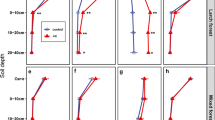Abstract
Green leaf biomass of Tithonia diversifolia is high in nutrients and recognised as a potential source of nutrients for crops. We conducted a field survey in western Kenya to determine the variation in leaf nutrient concentrations in tithonia grown in naturalised hedges and agricultural fields, and to examine whether leaf nutrient concentrations were related to soil nutrient status. Leaf P and K concentrations were higher in naturalised hedges (3.2 g P kg−1 and 35 g K kg−1) than in unfertilised fields (2.2 g P kg−1 and 23 g K kg−1). The critical level of 2.5 g P kg−1 for net P mineralisation was exceeded by > 90% of the leaves from hedges, but by only 14% from unfertilised fields. Leaf P and K concentration increased linearly with increasing natural logarithm of anion resin extractable soil P and exchangeable soil K, respectively. However, at the same levels of soil available P and K, field-grown tithonia consistently produced lower leaf P and K concentrations than that grown in hedges. This study indicates that biomass from tithonia planted on nutrient-depleted soils would be a less effective source of P and K, via biomass transfer, than tithonia from naturalised hedges.
Similar content being viewed by others
References
Blair GJ and Boland OW (1978) The release of P from plant material added to soil. Australian Journal of Soil Research 16: 101-111
Buresh RJ (1999) Agroforestry strategies for increasing the efficiency of phosphorus use in tropical uplands. Agroforestry Forum 9(4): 8-13
Buresh RJ and Niang Al (1997) Tithonia diversifolia as a green manure: Awareness, expectations and realities. Agroforestry Forum 8(3): 29-31
Gachengo CN, Palm CA, Jama B and Othieno C (1999) Tithonia and senna green manures and inorganic fertilizers as phosphorus sources for maize in western Kenya. Agroforestry Systems 44: 21-36
Genstat (1987) Genstat 5 reference manual. Genstat 5 Committee of the Statistics Department Rothamsted Experimental Station. Clarendon Press, Oxford, England
Iyamuremye F and Dick RP (1996) Organic amendments and phosphorus sorption by soils. Advances in Agronomy 56: 139-185
Jama B, Palm CA, Buresh RJ, Niang A, Gachengo C, Nziguheba G and Amadalo B (2000) Tithonia diversifolia as a green manure for soil fertility improvement in western Kenya: A review. Agroforestry Systems 49: 201-221
Maroko JB, Buresh RJ and Smithson PC (1999) Soil phosphorus fractions in unfertilized fallow-maize systems on two tropical soils. Soil Science Society of America Journal 63: 320-326
Murphy J and Riley JP (1962) A modified single solution method for the determination of phosphate in natural waters. Analytica Chimica Acta 27: 31-36
Niang A, Amadalo B, Gathumbi S and Obonyo CO (1996) Maize yield response to green manure application from selected shrubs and tree species in western Kenya: a preliminary assessment. In: Mugah JO (ed) Proceedings of the First Kenya Agroforestry Conference on People and Institutional Participation in Agroforestry for Sustainable Development, pp 350-358. Kenya Forestry Research Institute (KEFRI), Muguga, Kenya
Nziguheba G, Palm CA, Buresh RJ and Smithson PC (1998) Soil phosphorus fractions and adsorption as affected by organic and inorganic sources. Plant and Soil 198: 159-168
Palm CA, Myers RJK and Nandwa SM (1997) Organicinorganic nutrient interactions in soil fertility replenishment. In: Buresh RJ, Sanchez PA and Calhoun F (eds) Replenishing Soil Fertility in Africa. Soil Science Society of America Special Publication 51, pp 193-218. Soil Science Society of America, Madison, Wl, USA
Palm CA, Nziguheba G, Gachengo C, Gacheru E and Rao MR (1999) Organic materials as sources of phosphorus, Agroforestry Forum 9(4): 30-33
Parkinson JA and Allen SE (1975) A wet oxidation procedure suitable for the determination of nitrogen and mineral nutrients in biological materials. Communications in Soil Science and Plant Analysis 6: 1-11
Rao MR, Niang A, Kwesiga F, Duguma B, Franzel S, Jama B and Buresh R (1998) Soil fertility replenishment in sub-Saharan Africa: new techniques and the spread of their use on farms. Agroforestry Today 10(2): 3-8
Singh BB and Jones JP (1976) Phosphorus sorption and desorption characteristics of soil as affected by organic residues. Soil Science Society of America Journal 40: 389-394
Young, A. (1997) Agroforestry for soil management. CAB International, Wallingford UK and ICRAF, Nairobi, Kenya
Yurimaguas Experiment Station Staff (1989) Soil and plant methods used at the tropical soil laboratory, Yurimaguas. In: Hintze B (ed) First Training Workshop on Acid Tropical Soil Management and Land Development Practices. IBSRAM Tech. Notes no. 2, pp 163-175. IBSRAM, Bangkok, Thailand
Author information
Authors and Affiliations
Corresponding author
Rights and permissions
About this article
Cite this article
George, T.S., Gregory, P.J., Robinson, J.S. et al. Tithonia diversifolia: variations in leaf nutrient concentration and implications for biomass transfer. Agroforestry Systems 52, 199–205 (2001). https://doi.org/10.1023/A:1011896705132
Issue Date:
DOI: https://doi.org/10.1023/A:1011896705132




